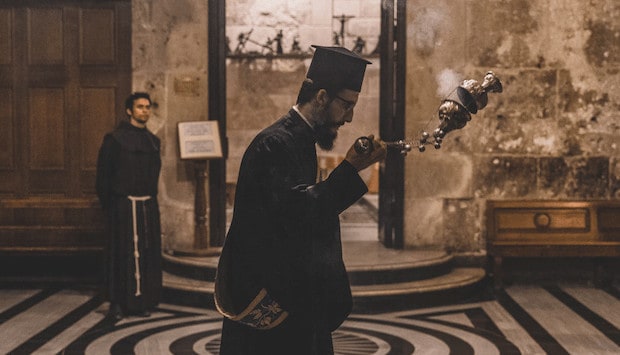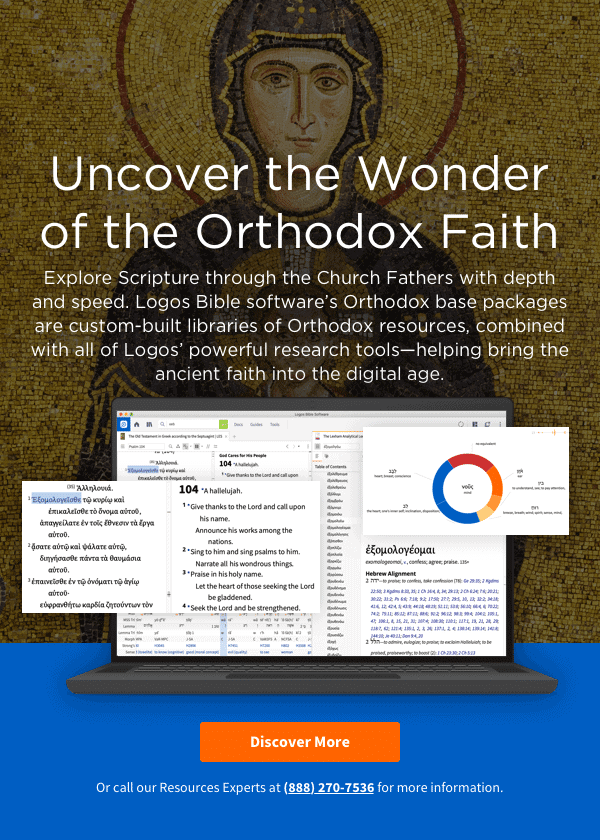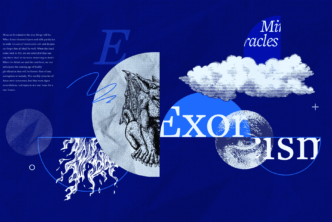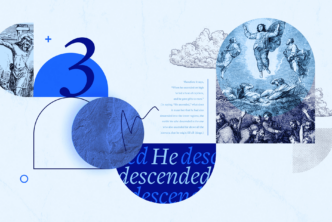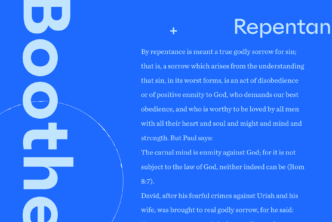Until 1054, there was simply the Church. No Eastern Orthodox Church, no Roman Catholic Church, no Reformation, and no denominations. There were just two large branches of the same tree: the church in the West and the church in the East.
But in 1054, tension between the two came to a head in what is now known as the Great Schism—a split between the two that has yet to be mended. The result was two broad strands of Christianity: the Roman Catholic Church and the Eastern Orthodox Church.
Here are nine facts about the Eastern Orthodox Church.
1. They split from the West for several reasons
On a basic level (whole books are written on these matters), the divisions between the East and West boiled down to doctrine, culture, and authority.
Though the schism is complex and any simple explanation is bound to miss much of the nuance, some of the primary issues related to:
- Language differences (broadly speaking, Eastern churches used a Greek rite and sacred text while the church centered in Rome used a Latin rite and the Latin Vulgate)
- The filioque clause, affirmed by the Western church as a part of the creed but denounced by the Council of Constantinople […]1
- The use of unleavened bread in the Eucharist by Western churches
- Ecclesiastical authority
The issue of ecclesiastical authority underlies and punctuates the specific doctrinal differences. In 553, John IV, Patriarch of Constantinople, adopted the title Ecumenical Patriarch. The pope objected to this title, arguing that it went beyond the authority and position afforded to the see of Constantinople. In 1054, Pope Leo IX sent a delegation led by Cardinal Humbert of Silva Candida, to object to the current Patriarch of Constantinople Michael I Cerularius’ use of the title Ecumenical Patriarch and to insist (among other things) that he recognize the pope as the head of the Church (caput et mater ecclesiarum). Cerularius refused and in response Humbert excommunicated him. Cerularius in turn excommunicated Humbert and the rest of the papal legates (notably, though, not Leo IX himself).
It is worth noting that though 1054 is generally held to be the formal date of the schism, there were many subsequent events (such as the crusades) that drove the two sides further apart. Though there were further attempts at reunification (such as the Council of Florence), nothing has been successful.
In 1965, Pope Paul VI and Patriarch Athenagoras I of Constantinople lifted the mutual excommunications. However, this was largely symbolic and didn’t resolve the original theological differences or the many doctrinal differences that had accumulated in the previous 1,000 years (especially the effects of scholasticism and the enlightenment on western theology).
2. The Orthodox Church affirms the Nicene Creed, but with one exception
The Orthodox Church affirms the Nicene Creed, but slightly different from the Western church. The Orthodox Creed does not include the phrase “and the son” (Latin filioque). With the filioque clause, this section in the creed reads:
I believe in the Holy Ghost, the Lord, the giver of life,
who proceedeth from the Father ⟨and the Son⟩.
Who with the Father and the Son is adored and glorified.
Why was this phrase added, and why did the Eastern church object to it?
In an attempt to counter Arian claims that Christ was different from God the Father, a sixth-century church council in Toledo, Spain, added the word filioque to a creed describing the procession of the Holy Spirit. The creed affirmed that the Holy Spirit was sent by the Father and the Son (John 14:26). The Eastern church objected to this addition, arguing that it exceeded what the Bible said about the procession of the Spirit […].2
3. Orthodox means “straight teaching”
The word Orthodox literally means “straight teaching” or “straight worship,” being derived from two Greek words: orthos, meaning “straight,” and doxa, meaning “teaching” or “worship.” As the encroachments of false teaching and division multiplied in early Christian times, threatening to obscure the identity and purity of the Church, the term “Orthodox” quite logically came to be applied to it.
4. The Orthodox Church doesn’t have a pope
Whereas the head of the Roman Catholic Church, the bishop of Rome (the pope), resides in the Vatican, the Orthodox Church does not necessarily have one primary leader.
If there were one, though, it would be the Ecumenical Patriarch, the head of the Eastern Orthodox Church, the Archbishop of Constantinople. He resides in Istanbul, Turkey, and is considered “primus inter pares (first among equals) among the heads of the several autocephalous churches that make up the Eastern Orthodox Church.”3
The current Ecumenical Patriarch is Bartholomew I of Constantinople.
5. Theosis is a major emphasis of the Orthodox Church
Théosis is becoming like God. It is “is the process of a worshiper becoming free of hamartía (“missing the mark”), being united with God, beginning in this life and later consummated in bodily resurrection. For Orthodox Christians, théōsis (see 2 Pet. 1:4) is salvation.”4
Athanasius, commenting 2 Peter 1:4, says that theosis is “becoming by grace what God is by nature.” In this way theosis is about more than sanctification; it is participating in the life of God and becoming more like him as we do.
6. The Orthodox Church highly values the Church Fathers
There is a strong sense in which the Orthodox Church sees themselves as the living continuation of the ideas of the Church Fathers, like St. John Chrysostom, Basil the Great, and Gregory of Nazianzus, known as “the three holy hierarchs.” St. John Chrysostom’s Easter homily, for example, is read in many Orthodox churches during the holiday.
7. Orthodox Churches are replete with iconography
Whereas Protestant churches are averse to iconography and images of God in worship, the Orthodox Church gives icons a prominent place in its worship.
The Greek Orthodox Church of America explains the presence of icon in their services this way:
An icon is a holy image which is the distinctive art form of the Orthodox Church. An icon may be a painting of wood, on canvas, a mosaic or a fresco. Occupying a very prominent place in Orthodox worship and theology, icons depict Christ Our Lord, Mary the Theotokos, the saints, and angels. They may also portray events from the Scriptures or the history of the Church, such as the Birth of Christ, the Resurrection, or Pentecost
The icon is not simply decorative, inspirational, or educational. Most importantly, it signifies the presence of the person depicted. The icon is like a window linking heaven and earth.5
8. Many Orthodox Churches lack pews or chairs; worshippers stand during the service.
First-time visitors to Orthodox churches are often surprised not to see pews or chairs in the nave. This is because most worshippers in this tradition stand during the service.
Rev. G. S. Debolsky explains that when the prophets saw visions of saints worshipping in heaven, the saints were standing (Isaiah 6:2; 1 Kings 22:19; Daniel 7:10; Apocalypse 7:11). Additionally, the saints in the Old Testament were said to be standing during their worship (2 Chronicles 5:12; 6:2; 20:5, 13; Nehemiah 8:7; 9:4, 5).6
In fact, it is technically forbidden to kneel on Sundays or during the Paschal season.
This tradition is a broader reflection of the Orthodox Church’s commitment to follow the Bible’s prescription for worship as closely as possible.
9. Orthodox priests can be married
The language is intentional here: “be married” versus “marry.” As Wesley Smith writes,
It is a misnomer to say that Orthodox priests can marry. They can be married, and indeed, most Orthodox priests are. But a priest can’t marry while a priest. If he wishes to have a family life, he must get hitched before he is ordained to the diaconate, the penultimate step before becoming a priest.7
In Eastern and Oriental Orthodox, it is the norm for bishops to be celibate.
There is much more to the Orthodox Church than these nine facts, of course. Explore our special Orthodox library packages in Logos, packed to the brim with enriching resources from the Orthodox tradition.
Explore Orthodox libraries in Logos.
- Points one and two taken from “Schism of 1054” in Pocket Dictionary of Church History.
- “Filioque” in Pocket Dictionary of Church History.
- “Ecumenical Patriarch,” Wikipedia.
- “Theosis,” Orthodoxwiki.org.
- “What to Expect When Visiting an Orthodox Christian Church,” goarch.org.
-
From Orthodox Life, Vol. 33, No. 6, pp. 48-49, excerpted from The Concern of the Orthodox Church for the Salvation of the World by Rev. G. S. Debolsky, translated from the Russian by Maria Naumenko. Found in the article “Why Orthodox Christians Stand During Divine Services,” orthodoxinfo.com.
- “Of Marriage and Orthodox Priests,” First Things.

